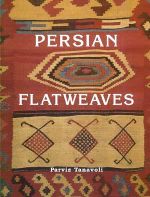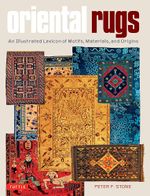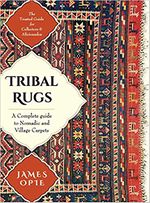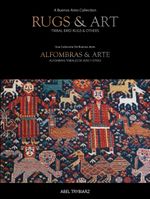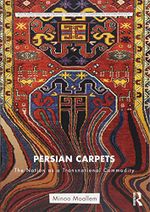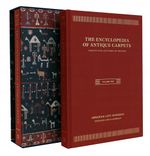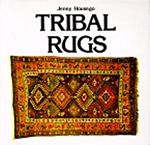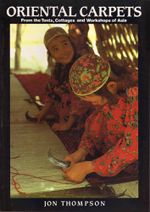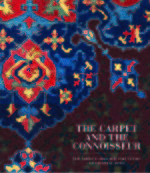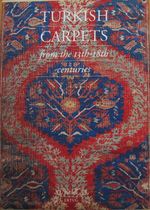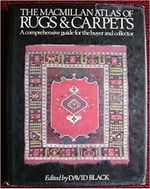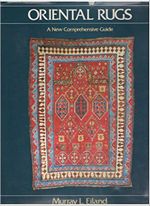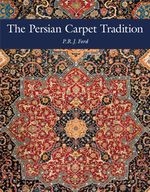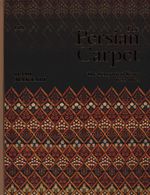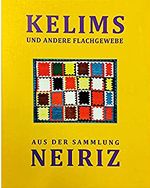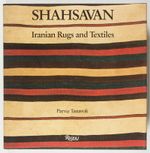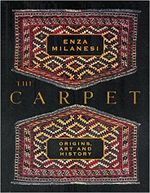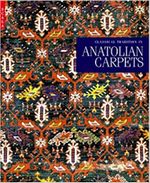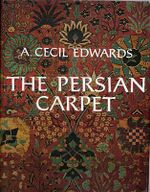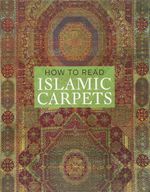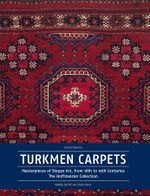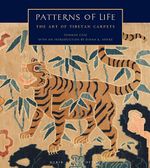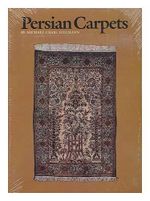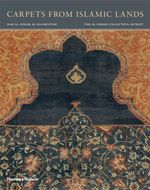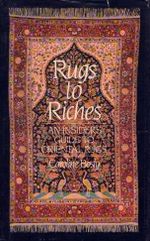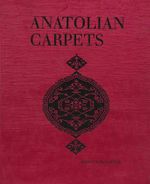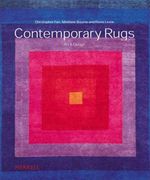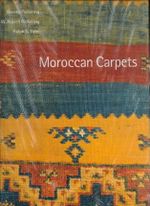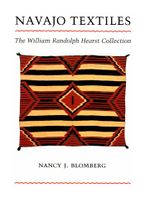WikiRug:Book of the week 2020
Week 6 2020
- week 1
- week 2
- week 3
- week 4
- week 5
- week 6
- week 7
- week 8
- week 9
- week 10
- week 11
Persian Flatweaves: a survey of flatwoven floor covers and hangings and royal masnads
Author: Parviz Tanavoli (translated from Persian to English by Amin Neshati)
This is the first comprehensive survey of the vast and fascinating subject of Persian flatweaves, and in particular floor covers. Previous publications on the subject have largely been dealers restricted catalogues focusing on a narrow geographical area or the weavings of a particular group, or sections in more general books. This book thus fills a huge gap in the oriental carpet and textile literature. Flatweaves have until recently been seen as merely the products and property of the poor. Since the late 1960s, however, growing attention has been paid to the best known type of flatweave, the gelim, revealing both its quality and variety. Other flatweaves, such as the palas, which is no less frequently found than the gelim, have scarcely been mentioned in any of the literature published so far, yet are shown in this work to be objects of great beauty and diversity.
The book is divided into two parts. The first deals with the cultural background to the subject. Drawing on literary sources as well as surviving examples, it describes the long history of flatweaves, showing their relation to pileweaves. The second part of the book deals with the different types of flatweave in turn: gelim, palas, weft-wrapped weaves, zilu and jajim. It also covers the range of uses to which they were put.
- week 12
Oriental Rugs: An Illustrated Lexicon of Motifs, Materials, and Origins
Author: Peter F. Stone (translated from Persian to English by Jalaedin Basam)
The Oriental Rugs: An Illustrated Lexicon of Motifs, Materials, and Origins book by Peter F. Stone, Lavishly illustrated with over 1000 photographs and drawings, it offers clear and precise definitions for the rug and textile terms in use across a broad swath of the globe—from Morocco to Turkey, Persia, the Caucasus region, Central Asia, Afghanistan, Pakistan, India and China. Covering priceless museum-quality rug traditions as well as modern centers of production, Oriental Rugs: An Illustrated Lexicon of Motifs, Materials, and Origins draws on classical scholarship as well as current terminology in use among producers and traders in these areas today. It focuses primarily on the rich hand-knotting and hand-weaving traditions of the Near East and Central Asia, but also includes some examples of Scandinavian and Native American weavings.
- week 13
Tribal Rugs: A Complete Guide to Nomadic and Village Carpets
Author: James Opie
The Tribal Rugs: A Complete Guide to Nomadic and Village Carpets book by James Opie, historian and dealer James Opie has compiled a detailed history of the rich tradition of rug weaving. Informed by years of careful study and innumerable trips to the bazaars and villages where these gorgeous carpets are woven and sold, this lavishly illustrated book clearly explains the history and culture surrounding a wide variety of Oriental rug styles, in addition to the weaving and dyeing techniques, tools, and materials used in their creation. Tribal Rugs traverses the Islamic World, investigating the rugs historically created by the nomadic peoples of Iran, Afghanistan, Turkey, The Caucasus And Central Asia Replete with full-color photos and detailed information, Tribal Rugs captures the deep beauty and artistry of Oriental rugs in many shapes and styles. This engaging, trusted guide is perfect for the coffee tables and libraries of rug collectors, aficionados, artists, and historians.
- week 14
Rugs & Art: Tribal Bird Rugs & Others
Author: Abel Trybiarz
The Rugs & Art: Tribal Bird Rugs & Others book by Abel Trybiarz, built over many years by a Buenos Aires artist/architect, has at its heart a superb selection of 'Bird' designed rugs, alongside many other characteristic knotted-pile rugs woven by the nomadic tribes of the Khamseh Confederation in southwest Iran during the 19th century. In addition, smaller numbers of related weavings are featured, made by by neighbouring South Persian nomads (such as the Qashqa'i and the Afshar) as well as two highly focused groups of Shikli Kazak and 'Keyhole' design village rugs from the Transcaucasus region. The collector/author's lucid bilingual texts explain his passion for these stunning woven creations. His choices of collectable pieces are informed by his perspective as a successful artist and architect working in the Argentinian capital.
- week 15
Rugs & Art: Tribal Bird Rugs & Others
Author: Minoo Moallem
The Persian Carpets (Routledge Series for Creative Teaching and Learning in Anthropology) book by Minoo Moallem, the Nation As a Transnational Commodity tracks the Persian carpet as an exotic and mythological object, as a commodity, and as an image from mid-nineteenth-century England to contemporary Iran and the Iranian diaspora. Following the journey of this single object, the book brings issues of labor into conversation with the politics of aesthetics. It focuses on the carpet as a commodity which crosses the boundaries of private and public, religious and secular, culture and economy, modern and traditional, home and diaspora, and art and commodity to tell the story of transnational interconnectivity.
- week 16
The Encyclopedia of Antique Carpets: Twenty-Five Centuries of Weaving
Author: Abraham Levi Moheban
The Encyclopedia of Antique Carpets: Twenty-Five Centuries of Weaving book by Abraham Levi Moheban the diverse forms that the art and craft of the handwoven carpet has taken over twenty-five centuries, from the Far East to North Africa, from Europe to India, and within both hemispheres of the New World. The book features Classic Asiatic sources in the "Rug Belt"—Persia (Iran), Anatolia (Turkey), the Caucasus, China, India, and central Asia—and includes more than six hundred entries on all areas of historic carpet production, ranging from village to city and style to weaver. Each entry provides a photograph and information on the history, location, weaving period, technique, quality, design, coloration, size, and marketability of carpets produced around the world. This beautiful clothbound, two-volume boxed set is a comprehensive collection that is required reading for anyone with an eye on the antiques market or the cultural heritage of one of the oldest forms of artwork.
- week 17
Tribal Rugs: An Introduction to the Weaving of the Tribes of Iran
Author: Jenny Housego
Tribal Rugs: An Introduction to the Weaving of the Tribes of Iran book by Jenny Housego is regarded as the most authoritative work on tribal rugs. The colorful way of life, often associated with its arduous and ancient patterns of migrations through rugged and spectacular landscapes, forms the backdrop of this much needed book.This book paints a fascinating picture, not only showing superb examples of tribal rugs but also the way in which they are woven and the life of the tribes themselves.The author's many years of study and close association with the tribespeople responsible for these stunning rugs and fabrics enables her to speak with authority, not only about well-known groups such as the Qashqa'i of southwest Iran, the Baluch of the southeast, the widespread Kurds and the Turkoman, but also such important weaving groups as the Shahsavan of the north regions.In short, Jenny Housego is able to describe the rich elements in the design as well as giving technical notes on the weaving so that the text and pictures together form an essential introduction for anyone who knows or cares about rugs.
- week 18
Oriental Carpets: From the Tents, Cottages, and Workshops of Asia
Author: Jon Thompson
Oriental Carpets From the Tents, Cottages, and Workshops of Asia book by Jon Thompson is guide to the world of rugs and carpets received enthusiastic acclaim from general readers and students alike as the best introduction to the subject yet published. By discussing carpets in the context of the people who weave them, the book makes this complex and often jargon-ridden subject easily accessible. Using a scheme for dividing all carpets into four categories - tribal, cottage industry, workshop and court - Jon Thompson immediately makes plain for the less knowledgeable carpet-lover how to begin to trace the likely origins of carpets, to understand how they are made, and to appreciate how and why patterns differ. For he firmly believes that a real grasp of the subject depends not on learning names but on a much broader understanding. Written with unusual clarity and avoiding all use of jargon, this invaluable book contains more than 180 outstanding color illustrations. There are maps, a glossary, and a detailed guide for buyers and sellers - a humorous and often irreverent review of the trade that contains much valuable advice.
- week 19
The Carpet and the Connoisseur: The James F. Ballard Collection of Oriental Rugs
Author: Walter Denny & Thomas J. Farnham
The Carpet and the Connoisseur: The James F. Ballard Collection of Oriental Rugs by Walter Denny & Thomas J. Farnham includes an essay about James Ballard as a collector by Thomas J. Farnham. A second essay by Walter B. Denny places the collection in a larger art historical and historiographic context. All items have full catalogue entries, full colour illustrations, and front and back details showing technical features. Ballard Collection rugs in the museum’s inventory not exhibited are also included with a colour reproduction and technical data.
Following several years of extensive research, conservation, and photography, Saint Louis Art Museum's major 2016 exhibition highlights 50 carpets and two Persian pleasure tents assembled by one of the most important early twentieth-century American carpet collectors, James F. Ballard. The unique contents of the collection, outstanding quality of many of the rugs, and detailed technical content make this book a major contribution to the study of Islamic textiles and the field of Islamic art history as a whole. The compelling visual nature of the pieces will appeal to art historians, rug collectors, and the general public alike.
- week 20
Turkish Carpets from the 13th-18th centuries
Author: Ahmet Ertug
Turkish Carpets from the 13th-18th centuries by Ahmet Ertug is Massive and nicely produced catalog on an exhibition of carpets in the Museum of Turkish and Islamic Arts (26 September – 12 November 1996) on classical Anatolian carpets drawn from this collection, the Vakiflar Museum, Istanbul, the Museum of Islamic Art, Berlin, the Museum of Applied Art, Budapest, the Konya Mevlana Museum, and the private collection of Kirchheim, Heinrich.
- week 21
The Atlas of Rugs and Carpets: A Comprehensive Guide for the Buyer and Collector
Author: David Black
The Atlas of Rugs and Carpets: A Comprehensive Guide for the Buyer and Collector by David Black provides the interested layperson with an overview of carpet history, production, and design. The main part of the volume is a gazetteer, with maps, of carpet production areas the world over. Data for each region include history and typical characteristics of carpets woven in that area; clear photographs provide visual examples. The atlas covers not only Oriental carpets, but also European and North American. A few words of advice on the buying and care of carpets are appended. A good choice for public libraries. Shahsavan is an extraordinary work, a thorough portrait of an almost extinct art form. The Shahsavan are a confederation of Turkish-speaking tribes who inhabit northwest Iran. Given the political state of Iran and the breakup of tribal traditions, the rugs illustrated hereprimarily flat weaves with specific tribal usesare rarely produced anymore. The work is very well written and translated, and, despite the wealth of scholarly detail, can be appreciated by anyone with a love for and interest in carpets. The many clear diagrams and charts make this a good choice for weavers as well.
- week 22
Oriental rugs: A comprehensive guide
Author: Murray L Eiland
Oriental rugs: A comprehensive guide by Murray L Eiland focuses on the nineteenth- and twentieth-century weaving of the Middle and Far East. It begins with a brief history of carpets and goes on to discuss weaving techniques, dyes and design. Traditional practices are described, along with computer-aided design. The book then covers the full range of oriental rugs by country and region respectively, providing detailed information on the characteristics of each type, illustrated with colour plates of typical examples.
- week 23
The Persian Carpet Tradition
Author: P. R.J. Ford
The Persian Carpet Tradition book P. R.J. Ford is discibe between 1400 and 1500 a design revolution in Persia swept away a 2000-year-old tradition of carpet design, replacing abstract geometric patterns with complex floral scrolls dominated by a central medallion derived from the Chinese cloud-collar shape. This revolution represents a major event in world art history, comparable to that which occurred at the same time in Renaissance Italy. It was followed over the next four centuries by a second revolution, during which the principal design elements of the first permeated carpet production at every level throughout Persia and continue to dominate it to this day.
- week 24
The Persian Carpet: The Forgotten Years 1722-1872
'Author: Hadi Maktabi
The Persian Carpet: The Forgotten Years 1722-1872 by Hadi Maktabi sets out to investigate a significant yet overlooked era of carpet weaving in Iran. The time-span stretches between two highly significant dates, which are exactly 150 years apart. The first, 1722, marks the downfall of the Safavid dynasty. The second date, 1872, represents the formal start of the modern carpet revival, when increased demand attracted European attention and changed the industry's structure. Prevailing opinion has hitherto been that in-between not much happened and that there was an overall decline in carpet production. Thankfully that is not the case, otherwise this book would not exist. New evidence brings to light a period of design evolution, thriving workshops and prestigious commissions. Through careful study of documentary sources, artworks in different media but first and foremost the hand-knotted rugs themselves, the glory of this forgotten age of the Persian carpet is brought to life.
- week 25
Kilims and Other Flatweaves from the Neiriz
'Author: Hamid Sadighi Neiriz and Karin Hawkes
Kelims und Andere Flachgewebe By Create Hamid Sadighi Neiriz and Karin Hawkes with a contribution by John T. Wertime. The beautifully produced large format catalogue of the Neiriz Collection of antique kilims and other flatweaves from Anatolia, the Transcaucasus region and Persia, with many previously unpublished and unseen examples of the highest quality, some of them ‘best of type’. The 190 kilims and other types of village, tribal and nomadic flatweaves illustrated represent the entire Neiriz Collection, past and present, including a small number of pieces now in the Ignazio Vok and other leading collections.
- week 26
Shahsavan: Iranian Rugs and Textiles
'Author: Parviz Tanavoli
Shahsavan: Iranian Rugs and Textiles By Create Parviz Tanavoli. Splendidly illustrated throughout with 495 photographic reproductions, including 96 in full color, this work provides a valuable historical and geographical background of the Shahsavan, with chapters on design and symbols as well as the changes in methods of weaving brought on by the progressive contact of the tent-dwelling tribes with modern, urban ways of life. All the pieces illustrated in this volume come from the Shahsavan community in Iran. Minor shelf wear.
- week 27
The Carpet: Origins, Art and History
'Author: Enza Milanesi
The Carpet: Origins, Art and History by Create Enza Milanesi. From the perspective of Western culture, it is not always easy to understand the complexities of the antique Oriental carpet. Part of the fascination lies in its dual nature as a simple, even humble artifact intended to be used in a variety of ways as well as a sophisticated artistic object with ancient designs unfamiliar to us. Providing the tools to understand the decorative and technical aspects of a carpet, including its geographic area of production, The Carpet: Origins, Art and History is a handsome reference book for lovers of art and antiques who are eager to deepen their knowledge of this intriguing world. Intentionally neither a manual nor a guide, this book aims to inform and captivate.
The Carpet celebrates its subject with clear and concise text as well as photographs and design diagrams that illustrate the most important ancient carpets. The stunning photographs capture the beauty and intricacy of this extraordinary art and play an important role in the critique and analysis of the various carpet specimens. With diagrams and drawings, this book provides an inspiring study of the carpet in all its dimensions, from decoration and its interpretation to the layout system, the ornamental motifs and their symbolic meaning and origin.
- week 28
Classical Tradition in Anatolian Carpets
'Author: Walter B. Denny
Classical Tradition in Anatolian Carpets by Walter B. Denny draws on the unparalleled collection at Washington's Textile Museum, as well as from other museums and private collections, dealing with issues such as history, lineage, design origins and meaning across the whole spectrum of Turkish carpet weaving.
A fresh and concise look at Anatolian carpets from the 14th to the 20th centuries, including some of the oldest surviving examples of Turkish carpets. Turkish rugs have been a part of European culture since the 14th century. Far more embedded in the Western consciousness than any other carpet type, they are among the most sought-after of all rugs by museums and collectors today.
- week 29
The Persian Carpet: A Survey of the Carpet-Weaving Industry of Persia
'Author: A. Cecil Edwards
The Persian Carpet: A Survey of the Carpet-Weaving Industry of Persia by create A. Cecil Edwards. Edwards, a leading figure in the rug business, rose to the top of his profession and became managing director of the legendary Oriental Carpet Manufacturers based in Turkey. In this unique book, containing over four-hundred images and an eight page color plate section, he shares his invaluable knowledge and takes the reader on a diverse and colorful journey through history, showcasing the vast range of carpets woven in Persia from 1850 through to the twentieth century. He explores the rich diversity and elaborateness of colors and designs available, from the traditional to the more modern and explores regional variations, styles, and terminologies. Inside these pages you will find detailed information on different symbols and motifs, discussions on knots, weaving and dyeing, and what to look for in terms of quality. Presented in an informative and accessible style, Edwards' love of the product and the industry shine through in his writing, presenting the reader with expert advice and knowledge as well as painting a fascinating cultural and historical landscape. This is a timeless book presented in a beautiful new package, and is a must-have for anyone interested in Persian carpets.
- week 30
How to Read Islamic Carpets (The Metropolitan Museum of Art - How to Read)
'Author: Walter Denny
How to Read Islamic Carpets (The Metropolitan Museum of Art - How to Read) by create Walter Denny. Carpets made in the “Rug Belt”―an area that includes Morocco, North Africa, the Middle East, Central Asia, and northern India―have been a source of fascination and collecting since the 13th century. This engaging and accessible book explores the history, design techniques, materials, craftsmanship, and socioeconomic contexts of these works, promoting a better understanding and appreciation of these frequently misunderstood pieces. Fifty-five examples of Islamic carpets are illustrated with new photographs and revealing details. The lively texts guide readers, teaching them “how to read” clues present in the carpets. Walter B. Denny situates these carpets within the cultural and social realm of their production, be it a nomadic encampment, a rural village, or an urban workshop. This is an essential guide for students, collectors, and professionals who want to understand the art of the Islamic carpet.
- week 31
Turkmen Carpets: Masterpieces of Steppe Art, from 16th to 19th Centuries The Hoffmeister Collection
'Author: Elena Tsareva
Turkmen Carpets: Masterpieces of Steppe Art, from 16th to 19th Centuries The Hoffmeister Collection, create by Elena Tsareva. The Hoffmeister Collection is one of the best and most extensive private collections of antique and historic Turkmen knotted carpets in Western Europe and America. It competes alongside important collections from Western museums as well as those in Russia and Turkmenistan. With almost 200 objects - among which are distinguished carpets and bags - artistic excellence and historical significance come together. As one of the first to do so, Hoffmeister has determined the age of these knotted works of the Turkmen with the aid of radio-carbon techniques. According to the results from the science and technology university ETH in Zurich, the earliest pieces of the collection originate from the sixteenth century.
Both the cultural significance of the collection and the scientific and artistic value of its pieces are discussed in this book. The readers can really sense the texture of these knotted wares through the brilliant photography, which carry them away on a journey into the lost world of the Steppes folk of Central Asia.
- week 32
Oriental Rug: The Carpets of Afghanistan
'Author: R. D. Parsons
Oriental Rug: The Carpets of Afghanistan, create by R. D. Parsons. Richard Parsons treats the reader to not only a veritable feast of carpets and rugs, but also to a fascinating journey through the history of a diverse, colourful, multi-racial country. He shares his respect and admiration for Afghanistan's stoical people, who somehow, despite political upheavals, forced resettlement, a harsh climate and often primitive nomadic living conditions, manage to produce exquisite works of art which reflect great pride in their many-faceted heritage. Afghan rugs are instantly appealing due to their traditional colours and bold designs, from sumptuous piled purdahs to flat woven prayer rugs.
- week 33
Caucasian Carpets and Covers: The Weaving Culture
'Author: Richard E. Wright, John T. Wertime
Caucasian Carpets and Covers: The Weaving Culture, create by Richard E. Wright, John T. Wertime. Caucasian Carpets & Covers is the first book to offer a comprehensive view of nineteenth and twentieth century knotted pile rugs and flat-woven textiles from Caucasia in the light of recent research. Written by two acknowledged experts in the field, the text is securely based on original written and photographic sources, coupled with a systematic analysis of woven structures. The collapse of the Soviet Union and the consequent opening up of communication and trade between the West and the newly independent Caucasian republics has resulted in the release onto the market of previously little known items, in particular flat-weaves. This development calls for a re-evaluation of the subject of Caucasian weaving, a demand which this book seeks to answer. The authors suggest that utilitarian flat-woven covers and containers - many of them spectacularly graphic and colourful - are the true traditional products of Caucasia's weaving culture.
- week 34
Qarajeh to Quba: Rugs and Flatweaves
'Author: Raoul E. Tschebull
Qarajeh to Quba: Rugs and Flatweaves, create by Raoul E. Tschebull. This book features the collector/author's well informed views about a careful selection of mainly 19th century knotted pile carpets and flatwoven covers in various techniques from his own extensive collection, which has been built up over a period of more than five decades. Many of the rugs, which are all of the highest graphic and artistic quality, have been acquired without recourse to the open market and are therefore previously unseen and unpublished. Raoul (Mike) Tschebull's long experience in the genre allows insights that go beyond the conventional wisdom of the traditional antique oriental carpet bazaar. His collecting career began under the aegis of one of the great US collectors of a previous generation, Joseph V. McMullan.
- week 35
Stars of the Caucasus: Silk Embroideries From Azerbaijan
'Author: Michael Franses
Stars of the Caucasus: Silk Embroideries From Azerbaijan, create by Michael Franses. Published on the occasion of an important international loan exhibition at The Azerbaijan National Museum in Baku, this multi-author book is much more than a mere catalog. Containing previously unpublished research and a wealth of previously hidden material from museums and private collections around the world, and written by a team of international museum professionals and independent scholars, it is the first coordinated and detailed study of the West Caspian region's characteristic silk embroideries. The book traces the history of embroidery in the Caucasus, the multi-cultural sources of domestic embroidery, iconography and designs in which the textile traditions of the Iranian and Turkic worlds meet, materials and needlework techniques, as well as the relationship between embroidery and the pile carpet weaving tradition in the region.
- week 36
Carpets and Rugs of Europe and America
'Author: Sarah B. Sherrill
Carpets and Rugs of Europe and America, create by Sarah B. Sherrill. In this comprehensive volume, Sarah Sherrill examines Western carpet design and production from the Middle Ages to the present, in styles that range from magnificent palatial creations to delightful folk designs. With hundreds of dazzling illustrations, Sherrill's authoritative text includes chapters on Moorish weavers and the golden age of carpets in Spain; the exquisite carpets of the Savonnerie, Aubusson, and Beauvais in France; productions from Moorfields, Exeter, and Axminster in England; the intriguing but little-studied rugs of Eastern European countries; the charming and resourceful rugs of America; and an important chapter on modern designs that offers an extensive survey of rugs created by leading artists and architects of the nineteenth and twentieth centuries. Sherrill's stimulating text, based on years of research, brims with interesting new findings, not only on the history and design of these works, but also technological developments that had an often unrecognized effect on rug design and production.
- week 37
Patterns of Life: The Art of Tibetan Carpets
'Author: Thomas Cole
Patterns of Life: The Art of Tibetan Carpets, create by Thomas Cole. Tibetans have used carpets for decorative and functional purposes, favoring colorful dyes and lively designs to enrich their homes and monasteries. Not bound by the codified rules governing the creation of religious art, the artisans who wove carpets often demonstrated a delightful sense of imagination in their work, drawing inspiration from a wide range of sources. Carpet motifs such as medallions and checkerboard patterns suggest considerable influence from Tibet's historical textile trading partners, countries as close as China and as distant as Iran. Other popular imagery, such as the snow lion, is indigenous to the region. With exceptional examples of saddle rugs, sleeping rugs, pile pillows, cushion covers, and door rugs, Patterns of Life explores the stylistic variety and uses of Tibetan carpets in the everyday life of the Tibetan people.
- week 38
Persian Carpets
'Author: Michael C Hillmann
Persian Carpets, create by Michael C Hillmann. Michael Hillmann , author of this book was Professor, Department of Middle Eastern Studies, The University of Texas at Austin. Volume includes a total of 6 color photos of carpets and a few black & white also. Chapters include: 1. Intro 2. Identification & Classification of Persian Carpets 3. Portfolio of Modern Persian Carpets 4. Symbolism in Modern Persian Carpet Designs 5. Persian Carpets and Iranian Society.
- week 39
Carpets from Islamic Lands
'Author: Friedrich Spuhler
Carpets from Islamic Lands, create by Friedrich Spuhler. Among the most beautiful and precious textiles in the world, carpets from Islamic lands have been treasured for centuries. These woven and knotted masterpieces are both distinguished works of art and utilitarian objects that offer a glimpse of life in the Islamic world.
This book features some of the finest classical carpets from the sixteenth to the nineteenth centuries, all from the spectacular al-Sabah Collection. Carpet and textile expert Friedrich Spuhler describes the Collection in the context of the history of Islamic art and recounts the stories behind individual carpets.
The book includes pictures of many carpets never before reproduced in print, and one that may have been lost forever following the Iraqi invasion of Kuwait in 1990. 112 color illustrations.
- week 40
Weavings of Nomads in Iran: Warp-faced Bands and Related Textiles
'Author: Fred Mushkat
Weavings of Nomads in Iran, create by Fred Mushkat. There is a rich tradition of hand-woven bands made by the nomadic pastoralists of Iran. They have a large and detailed design vocabulary and were executed using weaving skills that were not exceeded by any other weaving tradition. No study of nomadic life and weavings in Iran is complete without them. Among Qashqa'i tribal weavers in particular, the warp-faced bands used to attach loads to pack animals were a key symbol of their nomadic life. These bands carry a large repository of motifs that may be a source of archaic design elements. Bands illustrate a connection between and among groups of nomadic pastoralists, as great distances may have separated their ancestors for hundreds of years. Although the overwhelming majority of weavers were illiterate, they possessed a different form of literacy in which they were capable of transferring an image into a woven structure. This is the first book devoted exclusively to these weavings.
Contents: Introduction; The Functions of Warp-faced Bands in Nomadic Life; Structure and Construction; Buckles & Fastening Systems on Bands; Dating Textiles; Design & Structural Changes on Nineteenth and Twentieth-Century Warp-faced Bands; Imagery & Design Elements; Tribal Confederacies; Plates; Bands, Ropes, Braids, and Tassels among Qashqa'i Nomads; Glossary; Bibliography.
- week 41
Turkmen Carpets: The Neville Kingston Collection
'Author: Elena Tsareva
Turkmen Carpets: The Neville Kingston Collection, create by Elena Tsareva. The publication introduces for the first time the extraordinarily rich yet previously unknown British collection of Turkmen tribal carpets, rugs and trappings by Neville Kingston. The exceptional private collection forms the departure point for an exciting account of the development of the Turkmen weaving tradition, which lies at the heart of Eurasian textiles.
Thanks to Elena Tsareva's extensive study of the art of Turkmen carpets in the light of archeological and historical data, a complex picture of central Asian textiles has emerged. It shows how every epoch has contributed to the fundamentals of carpet-weaving and enriched it with new motifs, compositions and techniques.
- week 42
Knots: Art & History: The Berlin Carpet Collection
'Author: Anna Baselin
Knots: Art & History: The Berlin Carpet Collection, create by Anna Baselin. The Museum of Islamic Art in Berlin boasts one of the oldest collections of Islamic Art in Europe, and an incomparable collection of some 500 knotted carpets from the Islamic world. Knots: Art & History presents a selection of 45 of the best, most unique carpets in that collection, illustrated in stunning detail. Featuring objects made from the 14th through the 17th centuries in Spain, Egypt, Anatolia, the Ottoman Empire, the Caucasus, Persia and India, this publication shows the breadth and depth of the Berlin collection.
The selected carpets narrate the collection’s own eventful history, from the early 20th-century birth of European research into Islamic Art and Wilhelm von Bode’s foundation of the museum through the Cold War–era division of the collection and its 2001 reunification. This volume presents the Berlin Museum’s reunited carpet collection for the first time in English.
- week 43
Rugs to Riches
'Author: Caroline Bosly
Rugs to Riches, create by Caroline Bosly. Rugs to Riches is an authoritative, lively, and eminently practical guide for people who want to learn the dos and don'ts of choosing handmade oriental rugs. Caroline Bosly, one of the foremost rug brokers in the world, describes the various types of rugs and their origins, explains the difference between buying new and antique rugs, and tells you how to buy a rug of any size at the best possible price. Written in a simple, straightforward style that strips away the mystique from oriental rugs, Rugs to Riches also advises you on:
Determining whether a rug is handmade or not, and whether it has been altered in any way.
Evaluating a rug's condition and determining whether the retail price is a fair one, using a simple point system.
Bargaining down the price of a rug, no matter what type of store you find it in.
Selling a rug and making a profit.
Decorating with oriental rugs and ensuring that they remain clean and in good repair.
- week 44
Anatolian Carpets
'Author: Ertug and Kocabiyik
Anatolian Carpets, create by Ertug and Kocabiyik. Ertug & Kocabiyik provided funding for the conservation of one hundred forty unique Turkish carpets, nearly all of which had never been published. Ahmet Ertug photographed the carpets using large format cameras to achieve minutely detailed images that will provide connoisseurs of carpets and textiles with an unmatched visual experience. The book has received excellent reviews in leading carpets and textiles magazines. The most lavish publication of the second half of the 20th century in the field of oriental rugs.
- week 45
Contemporary Rugs: Art and Design
'Author: Christopher Farr, Matthew Bourne, Fiona Leslie
Contemporary Rugs: Art and Design, create by Christopher Farr, Matthew Bourne and Fiona Leslie. The book begins by charting the evolution of rug design over the last 100 years, before featuring innovative rugs by more than 50 contemporary international designers. With biographies of key designers and producers of the last 30 years, a technical glossary, and an international directory of sources and resources, Contemporary Rugs: Art and Design is simply indispensable to designers, collectors, architects and anyone interested in textile design.
- week 46
The Splendor of Antique Rugs and Tapestries
'Author: Parvis Nemati
The Splendor of Antique Rugs and Tapestries, create by Parvis Nemati. For centuries, the design woven into Oriental rugs and the distinctive artistry of each rug-weaving area has reflected an uninterrupted cultural and historical tradition. The Splendor of Antique Rugs and Tapestries celebrates this glorious tradition in its sumptuous presentation of the remarkable achievements of weaving from the Oriental and Occidental world.
Parviz Nemati believes that handmade carpets and tapestries are the most expressive works of art that have ever been created. Following a history of rug making and an explanation of the techniques and materials used, the characteristics of Persian, Turkish, Caucasian, Turkmen, Indian, Chinese, and European rugs and tapestries are richly illustrated and described through 300 color plates and an authoritative text that explores the heritage of both Oriental and European weaving.
- week 47
One Hundred Years of Navajo Rugs
'Author: Marian E. Rodee
One Hundred Years of Navajo Rugs, create by Marian E. Rodee. This history of Navajo weaving is a revised, expanded, and updated version of Marian Rodee's 1981 classic Old Navajo Rugs: Their Development from 1900 to 1940. Designed for the general reader, museum goer, or collector, it offers a guide to identifying and dating rugs by means of weaving materials. Wool quality, the author explains, is the single most important clue to the date of a rug's manufacture. Rodee also provides historical background on the great Navajo weavers and especially on the traders who bought rugs from the Navajo--Cotton, Moore, Hubbell, Bloomfield, McSparron, and others--all of whom had some influence on the development of the craft and patterns of Navajo weaving.
Since the first edition of this book, more information about more collections of rugs has become available, and this new edition includes a greatly expanded section of color plates in addition to sixty-four black-and-white photographs. Rodee has also added a map of the Navajo Nation showing the location of trading posts and outlet stores.
- week 48
An Illustrated Guide to Making Oriental Rugs
'Author: Gordon W. Scott
An Illustrated Guide to Making Oriental Rugs, create by Gordon W. Scott. This book takes the mystery out of this centuries-old art form by illustrating, in detailed steps, how to build a loom and handknot a rug as fine and intricate as those originating in the Middle East and the Orient. This unique book is a comprehensive self-instruction manual, written for both the diligent beginner and the experienced weaver, as well as the needlepoint devotee searching for challenging new designs.
- week 49
Oriental Rugs: An Introduction
'Author: Gordon Redford Walker
Oriental Rugs: An Introduction, create by Gordon Redford Walker. The rugs of Persia, Turkey, and many other countries of Muslim Asia constitute one of the richest seams of art anywhere in the world-and it is an art that can be part of one's home, adding character and distinction to even the smallest room. But the infinite variety of styles, sizes, and prices, as well as the difficulty of assessing value and authenticity, frequently intimidates the inexperienced purchaser. Here, at last, is a simple but serious introduction for the novice, providing a complete overview of the subject in a well-organized, easily followed text. Expert Gordon Walker explains the vocabulary of rugs, the techniques of identification, how rugs are made, the great families of rug styles, and the pitfalls that await the unwary buyer. A most welcome guide, complete with a color-coded chart to help with decorating schemes and 200 fine color photos.
- week 50
One Thousand Years of Turkish Carpets
'Author: Oktay Aslanapa
One Thousand Years of Turkish Carpets, create by Oktay Aslanapa. The history of oriental carpet-making is intertwined with the lives of people, Turkic people who have migrated through the centuries from Central Asia Westwards. This book begins with a look at early carpet fragments those prior to the first Turkic migrations. Then the study follows the people west into Muslim lands and then into the non-Muslim world. We see the encounter with the Abbasids (Samarra), the art of the Anatolian Selcuk Period, the Emirate Period and Ottoman times up to the present. Paintings and miniatures abound with depictions of carpets produced during the centuries in this history.
- week 51
Oriental Carpets and Their Structure
'Author: Jennifer Wearden
Oriental Carpets and Their Structure, create by Jennifer Wearden. Showcases one hundred definitive examples from the Victorian and Albert Museum collection, offering insight into major carpet-weaving traditions from China to Turkey while explaining through diagrams and photographic details how to examine and interpret the structure of individual carpets.
- week 52
Moroccan Carpets
'Author: Brooke Pickering
Moroccan Carpets, create by Brooke Pickering. This is the first book to offer a comprehensive survey of 19th and 20th century Moroccan rugs and textiles, and features an outstanding collection of mainly rural carpets and covers, tent-weavings, bags, trapping and garments in 115 stunning color plates.
The text examines the rice tradition of Moroccan textiles, which has emerged from a number of different weaving cultures: the indigenous Berber tribes of the High and Middle Atlas; the Arab-speaking tribes of the plains of Marrakesh; and the commercial urban centers of Rabat and Mediouna. This combination of origins has produced a richly varied weaving culture which is renowned for its use of strong color and geometric design. A chapter on the different weaving traditions is followed by sections on each region, illustrated with beautifully reproduced plates of the best examples.
- week 53
Navajo Textiles: The William Randolph Hearst Collection
'Author: Nancy J. Blomberg
Navajo Textiles: The William Randolph Hearst Collection, create by Nancy J. Blomberg. William Randolph Hearst's collection of Navajo textiles is one of the most complete gatherings of nineteenth-century Navajo weaving in the world. Comprising dozens of Classic Period serapes, chief blankets, Germantown eyedazzlers, and turn-of-the-century rugs, the 185-piece collection was donated to the Los Angeles County Museum of Natural History in 1942 but for the next forty years was known only to a handful of scholars. Hearst began acquiring textiles from the Fred Harvey Company after viewing an exhibit of Indian artifacts.
